Infections can be bacterial or viral, and they are often treated the same way. Antibiotics, however, have no effect on viral infections, unless there is a secondary bacterial infection.
Bacteria are living, microscopic, single-celled organisms. Antibiotics kill bacteria. Anti means “against” and biotikos means “fit for life.” Antibiotics prevent microorganisms from carrying on all their essential life functions, thereby causing their death.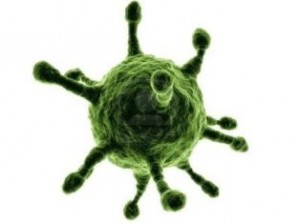
A virus is something different altogether. A virus is not really alive. A virus is basically a fragment of DNA in a protective coat. The virus comes in contact with a cell, attaches itself to the cell wall and injects its DNA, and perhaps a few enzymes, into the cell. The DNA uses the machinery inside the living cell to reproduce new virus particles. Eventually the hijacked cell dies and bursts, freeing the new virus particles. Or the viral particles bud off of the cell so it remains alive. In either case, the cell is a factory for the virus.
The best way to prevent viral infections from “going viral” is to keep your pet healthy with a strong immune system. See the section on Infections for more information. A well-balanced, natural, raw diet and a healthy lifestyle are the best safeguards.
Conventional veterinary medicine is big on pushing vaccinations. Over-vaccinating has become a top cause of immune-related disorders. The only two vaccinations that leading holistic veterinarians stand behind are those for distemper (panleukopenia in cats) and parvo. Generally, these can be given once, and your pet should be covered for life, p articularly if they have a healthy lifestyle and are raised on a well-balanced, natural, raw diet. The viruses for feline rhinotracheitis and calicivirus are not recommended, nor is the vaccination for feline leukemia, which can have dire aftereffects (see that section, below). See the following sections for more information on each viral disease.
articularly if they have a healthy lifestyle and are raised on a well-balanced, natural, raw diet. The viruses for feline rhinotracheitis and calicivirus are not recommended, nor is the vaccination for feline leukemia, which can have dire aftereffects (see that section, below). See the following sections for more information on each viral disease.
Rabies vaccinations are a tricky subject because so many laws are out of control in their demands for repeated vaccinations against rabies. Talk to a good holistic veterinarian. Most will do titrations which prove an animal’s immunity, and this may suffice in lieu of a repeated vaccination in many circumstances.
Below, we will describe some of the more common pet viruses.
Distemper, Chorea, Panleukopenia, and Feline Infectious Enteritis
These three viruses are grouped together because they are related. Canine distemper is what is commonly known simply as distemper. Chorea results when distemper affects the spinal cord, and panleukopenia is cat distemper or feline infectious enteritis.
Distemper
In dogs, distemper is as widespread as the common cold is among humans. Both are airborne viruses which will infect susceptible hosts. These viruses may also be contracted from infected surfaces. With people, you have probably noticed how some get colds and flus repeatedly, whereas others seem to never get sick. The same is true for pets. Trying to keep your dog from being exposed to the virus is not the answer.
 As described in the Infections section, a strong immune system is able to fend off viral entry into the cells of the body, and, if a virus does penetrate, a strong immune system will fight off the invasion before mass replication can occur and wreak havoc. A natural diet and healthy lifestyle is the best way to keep your pet’s resistance strong.
As described in the Infections section, a strong immune system is able to fend off viral entry into the cells of the body, and, if a virus does penetrate, a strong immune system will fight off the invasion before mass replication can occur and wreak havoc. A natural diet and healthy lifestyle is the best way to keep your pet’s resistance strong.
There is a six to nine day incubation period with distemper. During this time, you may not notice anything unusual. Then the animal’s temperature will spike, causing fever and lethargy. After that, it may seem as if your dog is fine, because the symptoms abate for three to eight days. Then more severe symptoms strike. These may include loss of appetite, listlessness, and a watery discharge from the eyes and nose. At this stage, distemper may be mistaken for a cold.
Within a few days, the eye and nasal discharge becomes thick, yellow, and sticky. The dog develops a pronounced dry cough. Blisters may appear on the abdomen, groin, or on the inside of the hind legs. Vomiting and diarrhea are frequent and may cause severe dehydration.
 In very bad cases, the dog’s brain may be attacked, causing encephalitis. This is characterized by brief attacks of slobbering, head shaking, and chewing movements of the jaws. Epileptic-like seizures may occur, in which the dog runs in circles, falls over, and kicks all four feet wildly. After the convulsive episode, the dog appears to be confused, shies away from his owner, wanders about aimlessly, and appears to be blind. Canine encephalitis is also known as hard pad or brain distemper because one of the final symptoms is a leathery thickening of the foot pads.
In very bad cases, the dog’s brain may be attacked, causing encephalitis. This is characterized by brief attacks of slobbering, head shaking, and chewing movements of the jaws. Epileptic-like seizures may occur, in which the dog runs in circles, falls over, and kicks all four feet wildly. After the convulsive episode, the dog appears to be confused, shies away from his owner, wanders about aimlessly, and appears to be blind. Canine encephalitis is also known as hard pad or brain distemper because one of the final symptoms is a leathery thickening of the foot pads.
The distemper virus tends to attack brain cells and cells that line the surfaces of the body, including the skin, the conjunctiva, the mucous membranes of the respiratory tract, and the gastrointestinal tract. The disease takes a variety of forms. Secondary infections and complications are common, partly attributable to the immunosuppressive effects of the virus.  This is why antibiotics are conventionally given when an animal is brought in with distemper. Some holistic veterinarians, however, believe that the use of antibiotcs increases the likelihood that the disease will progress to the brain, at which point it is often fatal.
This is why antibiotics are conventionally given when an animal is brought in with distemper. Some holistic veterinarians, however, believe that the use of antibiotcs increases the likelihood that the disease will progress to the brain, at which point it is often fatal.
In his book, Dr. Pitcairn’s Complete Guide to Natural Health for Dogs and Cats
Dr. Richard Pitcairn writes:
Though early in my career I treated many distemper cases with the orthodox approach of antibiotics, fluids, and other drugs, I did not see it do much good. Indeed, sometimes it seems to increase the likelihood of encephalitis, a severe inflammation of the brain (or smaller areas of the spinal cord) that often arises after apparent improvement or recovery. At this point dogs are usually put to sleep because medical treatment is almost always ineffective. I am convinced that the use of drugs increases the likelihood of encephalitis, while natural methods make it less probable. I have witnessed many successful recoveries in distemper cases treated with homeopathy and nutritional therapy.
 The famed herbalist Juliette de Bairacli Levy had decades of success treating distemper with her natural methods. Her book, The Complete Herbal Handbook for Dogs and Cats includes many reports from breeders who used her distemper cure. We definitely believe in the merit of her work, but we also urge you not to try to treat this viral disease by yourself. If you suspect your dog has distemper, see a holistic veterinarian as soon as possible.
The famed herbalist Juliette de Bairacli Levy had decades of success treating distemper with her natural methods. Her book, The Complete Herbal Handbook for Dogs and Cats includes many reports from breeders who used her distemper cure. We definitely believe in the merit of her work, but we also urge you not to try to treat this viral disease by yourself. If you suspect your dog has distemper, see a holistic veterinarian as soon as possible.
Meanwhile, read the section on infections for general advice on fighting infections and on boosting your pet’s immune system. Treatment almost always ought to begin with a fast. Dr. Pitcairn and other veterinarians with skill in this area say that withholding solid food while the dog is in the fever stage is crucial to preventing brain and spinal cord complications. See the section on fasting for more information. Vitamin C is important and is one of the best weapons against viruses. Zinc helps, as do the other infection fighters listed in the Infections section.
Make sure you have fresh, pure water constantly available, and try to reduce the stress in your pet’s environment.
A safe, dark, quiet place to recover is helpful when an animal is ill.
Distemperinum 30C is a homeopathic treatment used in the early stages of contraction. Please see a homeopathic veterinarian, however, instead of treating this illness on your own. There are other homeopathic treatments, as well.
See the Eyewashes section for various washes and wipes you can use to help alleviate the discomfort of eye discharge.
 Chorea
Chorea
If the distemper virus gets to the spinal cord, your pet’s nervous system may be damaged and certain muscle groups may encounter twitching. This is extremely serious. Once the virus has replicated destructively in the brain or spinal cord, most pets are considered terminal. There have been cases of recovery, though, so it may be worth giving alternative therapies a try if your pet is in this stage of disease. You can look on the internet or ask local holistic veterinarians for referrals to professionals who have experience treating chorea or brain distemper. Just be aware that, unfortunately, the odds are not in your pet’s favor. The distemper virus is deadly.
Dr. Pitcairn states, “If you really want to play it safe, keep your new puppy isolated from contact with other dogs and just vaccinate once.” He recommends the distemper vaccination at twenty two weeks of age. If you’re not comfortable with the single shot schedule, his second suggestion is to vaccinate once at sixteen weeks and then again at twenty-four weeks. The only other vaccine he advocates is parvo.
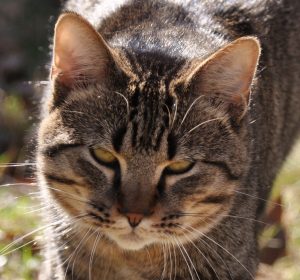 Feline Immunodeficiency Virus (FIV)
Feline Immunodeficiency Virus (FIV)
The feline immunodeficiency virus is similar in structure to the human acquired immunodeficiency syndrome virus, which is why FIV is sometimes called Feline AIDS. These are both retroviruses which depress the immune system. Feline immunodeficiency virus was discovered in 1986, and is believed to be transferred only through bite wounds.
FIV-infected cats are found worldwide, but the prevalence of infection varies greatly. In the United States, about two percent of healthy cats are infected with FIV. Rates rise significantly in cats that are sick or at high risk of infection. Roughly fifteen percent of sick cats brought into veterinary offices test positive for the virus. In Japan, the rate is about forty-five percent. Free-roaming, aggressive, intact male cats are the most frequently infected because they are more apt to get in fights and be bitten. Cats who live in environments where fights are unlikely, and who are raised on a well-balanced and nutritious raw diet are less likely to contract this disease.
Conventional veterinary medicine generally calls for frequent vaccinations, but holistic veterinarians believe this is not good. Annual revaccinations, they say, weaken the immune system and make a cat more susceptible.
If the feline immunodeficiency virus is not resisted by the immune system, the disease is very serious. As with human AIDS, the symptoms are wide-ranging. Because this virus suppresses the immune system, any little infection can become deadly.
In Dr. Pitcairn’s Complete Guide to Natural Health for Dogs and Cats, Dr. Richard Pitcairn gives advice on how to prevent this disease. He advocates the same natural diet we do in our Diet section, and a healthy lifestyle. This means reduced stress, reduced toxins in the environment, exercise, and limited vaccinations. Over-medicating and over-vaccinating our pets have weakened their immune systems and left them susceptible to many diseases which, unfortunately, we often consider inevitable when they are not.
Pitcairn goes on to say that if you bring a new cat into your home, isolate the new cat from any other cats in the house for at least three weeks. During this time have a test done for FIV. He stresses the fact that if your cat tests positive for FIV, it is NOT a good idea to vaccinate. This runs against conventional medicine. Dr. Pitcairn has extensive training and education in immunology. This, along with his clinical experience, has convinced him that immunizing an already infected cat 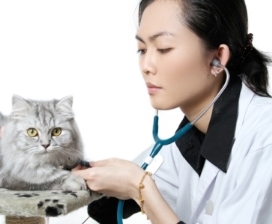 only further disturbs and weakens their already compromised immune systems.
only further disturbs and weakens their already compromised immune systems.
Our advice is to find a holistic veterinarian with good credentials – someone you can trust. Ask them about vaccinations. You also need to seek veterinary help if you suspect your cat has FIV. Do not try to treat this on your own.
Viruses and Retroviruses
A virus basically consists of a protein capsule with a nucleic acid inside. The nucleic acid could either be DNA or RNA. DNA is what we use for genetic material. If the virus uses DNA, the DNA can be directly inserted into the host genome and it will start producing clones.
Retroviruses, however, use RNA, which is like a mirror image copied from a section of DNA. RNA needs to be translated back to DNA using rRNA, tRNA, and enzymes. The translated strand is then inserted into the host genome.
The process of translating RNA back into DNA is not very accurate. Many times errors are made. And since the life cycle of a virus is very short, millions of copies can be made in a host in a very short amount of time. This speeds up evolution because the errors, or mutations, often become a new and improved strain. These viruses evolve faster than science can deal with them. AIDS and influenza are retroviruses. This is why flu shots change every year, because of the mutations. And often the flu shots don’t work because the virus that invades someone is not the same strain that they were vaccinated against.
Feline Infectious Peritonitis (FIP) and Caronavirus
Feline infectious peritonitis is a viral disease caused by certain strains of coronavirus. While FIP is serious and usually fatal, the coronavirus is not. Most cats infected with coronavirus lead perfectly normal lives.
Cats infected with coronavirus generally do not show any symptoms during the initial viral contraction. Some cats may show mild upper respiratory symptoms such as sneezing, watery eyes, and nasal discharge. Other cats may experience a mild intestinal disease and show symptoms such as diarrhea.
 Things can go awry when the immune system kicks in and antiviral antibodies are developed. Five to ten percent of infected cats develop an aberration either by a mutation of the virus or a deviation of the immune response. This is when the infection becomes serious. With the assistance of the antibodies that are supposed to protect the cat, white blood cells are infected with virus, and these cells then transport the virus throughout the cat’s body. White blood cells are part of the immune system involved in defending the body against infectious disease and foreign materials. It is this interaction between the body’s own immune system and the virus that is responsible for the disease. The way clinical FIP uses the immune system to assist its progression is dire and unique.
Things can go awry when the immune system kicks in and antiviral antibodies are developed. Five to ten percent of infected cats develop an aberration either by a mutation of the virus or a deviation of the immune response. This is when the infection becomes serious. With the assistance of the antibodies that are supposed to protect the cat, white blood cells are infected with virus, and these cells then transport the virus throughout the cat’s body. White blood cells are part of the immune system involved in defending the body against infectious disease and foreign materials. It is this interaction between the body’s own immune system and the virus that is responsible for the disease. The way clinical FIP uses the immune system to assist its progression is dire and unique.
Once the infection progresses into clinical FIP, the virus is then referred to as feline infectious peritonitis virus (FIPV). An intense inflammatory reaction occurs in the infected tissues, often in the abdomen, kidney, or brain. Symptoms may then appear to come on suddenly with increasing severity over the course of several weeks.
There are two major forms of FIP, an effusive, or “wet” form, and a noneffusive, or “dry” form. Generally, cats will exhibit the signs of the noneffusive, dry form more slowly than the effusive form. Symptoms generally include chronic weight loss, depression, anemia, rough hair coat, and a persistent fever.
The effusive form of FIP is characterized by an accumulation of fluid in the abdomen or chest, hence the term “wet.” Early in the disease, the cat may exhibit similar symptoms to the dry form, including weight loss, fever, loss of appetite, and lethargy. The wet form of the disease often progresses rapidly, and the cat may quickly appear pot-bellied due to fluid accumulation in the abdomen. When the fluid accumulation becomes excessive, it may become difficult for the cat to breathe normally.
FIP can be difficult to diagnose because each cat can display different symptoms that are similar to those of many other diseases. Once a cat develops clinical FIP, the disease is progressive and is almost always fatal.
 As with other infections, prevention starts with a healthy lifestyle. This includes a well-balanced, raw diet, regular exercise and exposure to direct sunlight, and not being inundated with excessive medications and vaccinations that depress the immune system. The latter, over-vaccinations, is thought by many experts to be a cause of FIP. In his book, Dr. Pitcairn’s Complete Guide to Natural Health for Dogs and Cats, Dr. Richard Pitcairn states, “I have seen many cases occur within a few weeks of the cat receiving a vaccine against feline leukemia – probably from a temporary immunosuppressive action of the vaccine (an effect known to occur with several vaccines).”
As with other infections, prevention starts with a healthy lifestyle. This includes a well-balanced, raw diet, regular exercise and exposure to direct sunlight, and not being inundated with excessive medications and vaccinations that depress the immune system. The latter, over-vaccinations, is thought by many experts to be a cause of FIP. In his book, Dr. Pitcairn’s Complete Guide to Natural Health for Dogs and Cats, Dr. Richard Pitcairn states, “I have seen many cases occur within a few weeks of the cat receiving a vaccine against feline leukemia – probably from a temporary immunosuppressive action of the vaccine (an effect known to occur with several vaccines).”  This is not to say that the vaccine directly causes the disease, but rather that it suppresses the immune system and gives the virus the opportunity to develop. Proponents of this theory believe that the cat already has picked up the virus in its benign form. Other professionals think that the two viruses, FIP and feline leukemia, are related, and that one is a mutant strain of the other. Both postulates are credible.
This is not to say that the vaccine directly causes the disease, but rather that it suppresses the immune system and gives the virus the opportunity to develop. Proponents of this theory believe that the cat already has picked up the virus in its benign form. Other professionals think that the two viruses, FIP and feline leukemia, are related, and that one is a mutant strain of the other. Both postulates are credible.
Once your cat shows dire symptoms, there is no point to quarantine. The cat is only infectious one to ten days after the initial contraction of the virus, during which time symptoms are not usually apparent. In other words, if your cat is around other cats, they probably already contracted the virus by the time you notice anything is wrong. And the cat is no longer shedding the virus once the symptoms become evident.
To make matters worse, FIP is very hard to accurately diagnose. If you believe your cat may have the virus, see a holistic veterinarian, preferably one who has experience with viral infections and is trained in immunology. If you take your cat to a conventional veterinarian, they will give conventional medications which will further depress the cat’s immune system, which is akin to giving up. While FIP is usually fatal, holistic veterinarians have reported cases where cats have recovered. The cat’s overall health is an important factor. Dr. Pitcairn tells readers that “there is a vaccine for this disease, but research has shown it to be useless or even harmful if the cat already has the virus in its body. Not recommended.”
Feline Leukemia (FeLV)
Feline leukemia is not the same as people’s leukemia. As with FIV and AIDS, feline leukemia is caused by a retrovirus (see the definition in the FIV section). The virus can cause cancer in the white blood cells, which is why this disease is called leukemia. This disease is unknown in cats in the wild, but has been found in caged felines in zoos and in housecats. It is not highly contagious, and can be spread by way of bites, grooming, and shared water bowls between cats, or from a mother cat through pregnancy or nursing. Many cats come into contact with the virus and aren’t affected. In the two to three percent of housecats that do become infected and symptomatic, those whose immune systems didn’t defeat the virus, the disease is very serious. FeLV occurs mostly in cats aged one to five years, and more in neutered cats than non-neutered.
 Symptoms of Feline Leukemia:
Symptoms of Feline Leukemia:
- Loss of appetite
- Slow weight loss which progress to severe wasting
- Poor coat condition
- Enlarged lymph nodes
- Persistent fever
- Pale gums and other mucus membranes
- Inflammation of the gums and mouth
- Infections of the skin, urinary bladder, and upper respiratory tract
- Persistent diarrhea
- Seizures, behavior changes, and other neurological disorders
- A variety of eye conditions
- Abortion of kittens or other reproductive failures
- The development of cancerous tumors
There are six stages in the development of Feline Leukemia:
- Stage One: The virus enters the cat, usually through the pharynx where it infects the mouth tissues.
- Stage Two: The virus enters the blood stream and begins to distribute throughout the body.
- Stage Three:
 The lymphoid system, which produces antibodies to attack infected and cancerous cells, becomes infected, with further distribution throughout the body. Even at this stage, most healthy cats can still defeat the infection.
The lymphoid system, which produces antibodies to attack infected and cancerous cells, becomes infected, with further distribution throughout the body. Even at this stage, most healthy cats can still defeat the infection. - Stage Four: The bone marrow becomes infected. At this point, the virus will stay with the cat for the rest of its life, but it may be controllable with proper treatment.
- Stage Five: The infection spreads again into the bloodstream, circulating through the body.
- Stage Six: The cat’s body is overwhelmed by infection and many tissues, glands, and organs are infected. The cat is shedding the virus and is contagious to other cats.
Prevention is the same as it is for any other viral disease. Read the beginning of this section for general information on preventing viral infections, and read the Infections section for more information. Most importantly, feed a well-balanced, raw diet with plenty of vitamins and nutrients,  particularly vitamin C. Many studies have showed the beneficial effects of vitamin C in fighting viruses.
particularly vitamin C. Many studies have showed the beneficial effects of vitamin C in fighting viruses.
If you suspect your cat may have the virus, see a holistic veterinarian, preferably one who has experience with viral infections and is trained in immunology. This disease used to be considered incurable, and oftentimes it is … but not always.
Feline Herpes, Feline Herpesvirus-1 (FHV-1), Feline Viral Rhinotracheitis (FVR), Feline Influenza (Flu), and Feline Coryza
Feline Viral Rhinotracheitis (FVR) is an upper respiratory or pulmonary infection of cats caused by
feline herpesvirus-1 (FHV-1). In other words, FVR is the disease, and FHV-1 is the virus. This disease is also known as feline influenza and feline coryza. FVR is the most common respiratory disease in cats, and is found worldwide in all feline species, such as lions in Germany.  Another common cause of feline respiratory disease is feline calicivirus.
Another common cause of feline respiratory disease is feline calicivirus.
FVR replicates in the nasal tissues and tonsils. The virus is shed in saliva and eye and nasal secretions. It can be picked up through direct contact with the secretions, or through surfaces that have been contaminated. FVR has a two to five day incubation period, and it is shed one to three weeks after infection.
Some cats can be carriers of herpesvirus-1. That is, they don’t show symptoms of FVR, but they are able to shed the herpesvirus all their lives. The shedding is brought on by stress and corticosteroids.
Symptoms of FVR include coughing, sneezing, nasal discharge, conjunctivitis (an eye disease), fever, and loss of appetite. These viral symptoms usually go away within a week, but secondary bacterial infections can cause further problems.
FHV-1 has a predilection for eye tissues, specifically, the corneal epithelium. The infection can result in corneal tears. Eye infections and inflammation are common results. FHV-1 can also result in abortion around the sixth week of pregnancy. This may be due to systemic effects of the infection, though, and not the virus directly.
As with all infectious diseases, the young are most susceptible because their bodies haven’t had time to develop proper immune defenses. Also, sometimes infection at an early age can permanently damage nasal and sinus tissue, which can predispose these cats to chronic bacterial infections.
If you suspect your cat has FVR, see a holistic veterinarian. Even holistic veterinarians will probably want to use an antibiotic if the symptoms have progressed to secondary bacterial infections.
 If the disease is caught in the early stages, a fast is appropriate. See the section on fasting. Give plenty of vitamin C and treat according to the section on infections. Clean the eyes and nose with a saline solution (see Conjunctivitis in the Eyes and Vision section).
If the disease is caught in the early stages, a fast is appropriate. See the section on fasting. Give plenty of vitamin C and treat according to the section on infections. Clean the eyes and nose with a saline solution (see Conjunctivitis in the Eyes and Vision section).
Most of the time, however, people don’t realize their cat has FVR until the symptoms have progressed to a later stage. Work with a holistic veterinarian and read the section on infections.
Feline Calicivirus (FCV)
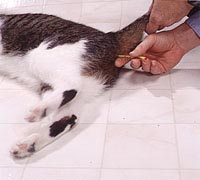 Feline calicivirus manifests itself with similar flu-like symptoms as feline herpesvirus-1, except the nose and eyes are usually not as severely affected. FCV symptoms also include ulcers of the tongue, the roof of the mouth, and the bottom of the nose. The difficulty in treating cats infected with FCV is that their mouth is so sore they are hard to treat. Consult with a holistic veterinarian. The same treatment described in the infections section applies to FCV infections. You may want to explore alternative methods of giving your cat supplements, such as suppositories. Talk with your holistic veterinarian.
Feline calicivirus manifests itself with similar flu-like symptoms as feline herpesvirus-1, except the nose and eyes are usually not as severely affected. FCV symptoms also include ulcers of the tongue, the roof of the mouth, and the bottom of the nose. The difficulty in treating cats infected with FCV is that their mouth is so sore they are hard to treat. Consult with a holistic veterinarian. The same treatment described in the infections section applies to FCV infections. You may want to explore alternative methods of giving your cat supplements, such as suppositories. Talk with your holistic veterinarian.
Dog Influenza
As with most viruses, flu viruses are generally species-specific. This means you can’t catch your cat’s cold and your cat can’t catch yours. However, also like all viruses, this virus multiplies rapidly, which means it can mutate into a new strain rapidly. It has become somewhat common that certain mutations of flu have developed the ability to spread from one particular species to another. This doesn’t mean that you get the same flu as your horse. It means that, for example, ducks may have a duck-specific flu that mutates into a virus that can infect pigs in the fish ponds. The mutated pig-specific virus can then mutate again into a strain that infects people. This is what happened with the Asian swine flu epidemic.
It means that, for example, ducks may have a duck-specific flu that mutates into a virus that can infect pigs in the fish ponds. The mutated pig-specific virus can then mutate again into a strain that infects people. This is what happened with the Asian swine flu epidemic.
The symptoms of influenza in dogs are the same as for people: fever, vomiting, diarrhea, body aches, respiratory problems, loss of appetite, and lethargy. See the section on Infections for more information. Generally, when the dog has a fever, a fast is in order. See the section on fasting.
Your dog should recover from dog flu on his own. You should see a holistic veterinarian, though, to rule out other diseases and, especially, if symptoms persist. Don’t give your dog antibiotics unless there is a secondary bacterial infection. Antibiotics have no effect on viruses, and overuse of antibiotics weakens the immune system. There is a vaccine for dog influenza, but we do not recommend it. Talk with a holistic veterinarian who is specifically trained in immunology if you are curious.
 Kennel Cough, Canine Infectious Tracheobronchitis
Kennel Cough, Canine Infectious Tracheobronchitis
Canine infectious tracheobronchitis, otherwise known as kennel cough or canine respiratory disease complex, can be caused by viral infections, such as canine distemper, canine adenovirus, canine parainfluenza virus, canine respiratory coronavirus or Orthomyxoviridae influenzavirus, or bacterial infections, such as Bordetella bronchiseptica. It is commonly called kennel cough because the infection can spread quickly among dogs kept in the same area.
Both viral and bacterial causes of kennel cough are spread through the air by infected dogs sneezing and coughing. It can also spread through contact with contaminated surfaces and through direct contact. It is highly contagious, even days or weeks after symptoms disappear. Symptoms appear anywhere from two to ten days after exposure, and can progress to pneumonia. From recent studies, kennel cough is now believed to be a zoonotic disease, meaning it can transfer from animal to human and vice versa.
The main indicator of canine infectious tracheobronchitis is a dry, hacking cough, often with gagging and retching. Other symptoms may include vomiting, clear, watery discharge from the eyes and nose, lethargy, loss of appetite, and fever, but this varies from case to case.
In most cases, the disease is viral, and antibiotics are not recommended. However, most conventional veterinarians will prescribe them, anyway, the same way many conventional doctors will give moms a prescription for antibiotics when they bring in their child who has a cold. As stated previously, antibiotics do no good against viral infections. They only fight bacterial infections. And the overuse of antibiotics weakens the immune system, causing further disease and giving viruses am advantage. See a holistic veterinarian, preferably one with experience in viral infections and one who has studied immunology.
In Dr. Pitcairn’s Complete Guide to Natural Health for Dogs and Cats, Dr. Richard Pitcairn says that the most effective thing you can do for a dog with kennel cough is to “place the dog in a steam-filled room (such as a bathroom with a tub full of hot water or after running a hot shower) or in a room with a cold-mist vaporizer. Veterinarians recognize this as a disease that just has to “run its course” (two to three weeks) before recovery.” He also advocates beginning treatment with a fast, giving immune-boosting supplements, and using an herbal cough treatment. See the Infections section for more information.
 Mullein is an herb that has been known for centuries to help with a dry, hacking cough. Make a strong tea and let it steep and cool. Peppermint, menthol, pine needle oil, slippery elm, and capsicum can also be beneficial as ingredients in a throat tonic.
Mullein is an herb that has been known for centuries to help with a dry, hacking cough. Make a strong tea and let it steep and cool. Peppermint, menthol, pine needle oil, slippery elm, and capsicum can also be beneficial as ingredients in a throat tonic.
A dry, hacking cough is not always kennel cough. For example, its also a symptom of heart disease. See a holistic veterinarian if you’re not sure what brought on the cough, or if symptoms persist.
Parvovirus
The root word “parvo” means small and was given to this virus because of its relatively tiny size. Parvovirus belongs to a viral family that has been long known to infect cattle, pigs, rodents, and cats. It’s only been since 1980 that the virus mutated to a dog-specific variety. Since then, it quickly spread and killed millions of dogs. When parvovirus is discussed, people are usually talking about canine parvo. Feline parvo is more commonly referred to as panleukopenia and may become feline infectious enteritis, which is also thought of as feline distemper, and is discussed in the Distemper section.
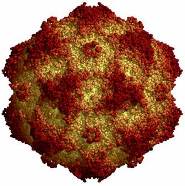 Canine parvovirus (CPV) is highly contagious between dogs and is spread directly or indirectly by contact with their feces. It can be especially severe in puppies that are not protected by maternal antibodies or vaccination. It has two distinct forms, cardiac and intestinal. The common signs of the intestinal form are severe vomiting and dysentery. The cardiac form causes respiratory or cardiovascular failure in young puppies. Treatment often involves veterinary hospitalization. Parvovirus infection is serious and has a high mortality rate. Canine parvovirus will not infect humans.
Canine parvovirus (CPV) is highly contagious between dogs and is spread directly or indirectly by contact with their feces. It can be especially severe in puppies that are not protected by maternal antibodies or vaccination. It has two distinct forms, cardiac and intestinal. The common signs of the intestinal form are severe vomiting and dysentery. The cardiac form causes respiratory or cardiovascular failure in young puppies. Treatment often involves veterinary hospitalization. Parvovirus infection is serious and has a high mortality rate. Canine parvovirus will not infect humans.
Symptoms crop up within three to ten days. The symptoms include lethargy, vomiting, fever, and diarrhea, which is usually bloody. Diarrhea and vomiting result in dehydration and secondary infections can set in. Due to dehydration, the dog’s electrolyte balance can become critically affected. Because the normal intestinal lining is also compromised, blood and protein leak into the intestines leading to anemia and loss of protein, and toxins escape into the bloodstream. Dogs have a distinctive odor in the later stages of the infection. The white blood cell level falls, further weakening the dog. Any or all of these factors can lead to shock and death. The first sign of CPV is lethargy. Usually the second symptoms would be loss of appetite or diarrhea followed by vomiting.
 Vaccination against parvovirus is one of the few vaccinations that holistic veterinarians will often recommend. In Dr. Pitcairn’s Complete Guide to Natural Health for Dogs and Cats, Dr. Richard Pitcairn states, “If you really want to play it safe, keep your new puppy isolated from contact with other dogs and just vaccinate once.” He recommends the parvo vaccination at twenty six weeks of age. If you’re not comfortable with the single shot schedule, his second suggestion is to vaccinate once at twenty weeks and then again at twenty-eight weeks. The only other vaccine he advocates is distemper.
Vaccination against parvovirus is one of the few vaccinations that holistic veterinarians will often recommend. In Dr. Pitcairn’s Complete Guide to Natural Health for Dogs and Cats, Dr. Richard Pitcairn states, “If you really want to play it safe, keep your new puppy isolated from contact with other dogs and just vaccinate once.” He recommends the parvo vaccination at twenty six weeks of age. If you’re not comfortable with the single shot schedule, his second suggestion is to vaccinate once at twenty weeks and then again at twenty-eight weeks. The only other vaccine he advocates is distemper.
Read the Infections section for general information on boosting the immune system and overall health. This is the best prevention against viral and all diseases.
Rabies
 Probably the most popularly known viral disease, rabies is a serious disease that is usually fatal by the time symptoms develop. The reason that it is so highly popularized and guarded against is that it is zoonotic, meaning that people can catch it from animals. The fear and hype this has induced has created a society that demands we vaccinate our pets against the disease yearly, even though it is thought that immunity lasts much longer. Currently, there has not been enough funding to support further research into studies that prove how long a rabies vaccination is effective. If you would like to support such a study, go to this website: www.rabieschallengefund.org .
Probably the most popularly known viral disease, rabies is a serious disease that is usually fatal by the time symptoms develop. The reason that it is so highly popularized and guarded against is that it is zoonotic, meaning that people can catch it from animals. The fear and hype this has induced has created a society that demands we vaccinate our pets against the disease yearly, even though it is thought that immunity lasts much longer. Currently, there has not been enough funding to support further research into studies that prove how long a rabies vaccination is effective. If you would like to support such a study, go to this website: www.rabieschallengefund.org .
Rabies is transmitted through biting. After a bite, the rabies virus travels slowly through nerves, taking three to eight weeks or longer to reach the brain. Most animals then go through one or more classical stages. Rabies, however, is a very variable disease. Those with exceptional immune systems can be bitten but unaffected.
Typcial Stages of Rabies:
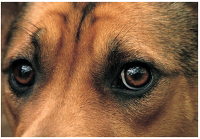 Stage One: In this stage, symptoms are generally negligible. In dogs, this phase typically lasts for two or three days. The animal often becomes nervous and anxious. It may withdraw from contact and run a fever. Personality changes are common. Friendly dogs may become fearful or aggressive and normally fearful or aggressive dogs may become overly friendly. Some observers say that their pet they frequently licks the bite site. Cats seem to go through this phase more rapidly than dogs. Some animals go straight from phase one to phase three.
Stage One: In this stage, symptoms are generally negligible. In dogs, this phase typically lasts for two or three days. The animal often becomes nervous and anxious. It may withdraw from contact and run a fever. Personality changes are common. Friendly dogs may become fearful or aggressive and normally fearful or aggressive dogs may become overly friendly. Some observers say that their pet they frequently licks the bite site. Cats seem to go through this phase more rapidly than dogs. Some animals go straight from phase one to phase three.
Stage Two: Once the virus has entered the nervous system, it is transported to the brain, and then to other highly innervated areas and to the salivary glands. This is when you will see slobbering and the virus is contagious to others. Soon after, you will see irritability to sight and sound, restlessness, and aggressiveness. This stage can last one to seven days. Eventually these animals become ataxic, or wobbly, and may develop seizures and die.
 Stage Three: This is the stage in which the nerves of the head and throat become paralyzed. The infected animal drools and walks about with its mouth open. The animal is unable to swallow and looks as though it may have something lodged in its throat. During a period of about a week, these animals become more and more paralyzed and finally die.
Stage Three: This is the stage in which the nerves of the head and throat become paralyzed. The infected animal drools and walks about with its mouth open. The animal is unable to swallow and looks as though it may have something lodged in its throat. During a period of about a week, these animals become more and more paralyzed and finally die.
There’s not much that can be said about rabies prevention at the moment because we are so constricted by laws to vaccinate, vaccinate, vaccinate. The best thing you can do, though, is to boost your pet’s overall health and immune system. Guidelines are given in the Infections section and throughout this website.
One thing that can be said is that most of the danger to humans from rabies is not from dogs and cats but from wild animals. Raccoons and skunks are at the highest risk for having the rabies virus, and yet some people catch these animals in the wild and adopt them as pets.
A final note, if you happen to have a wolf hybrid, rabies vaccinations are particularly unsafe because of specific risks of infection.